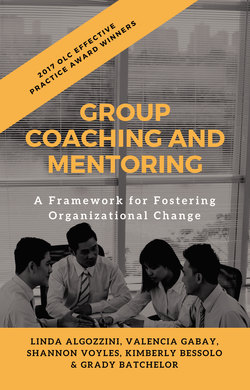Group Coaching and Mentoring

Реклама. ООО «ЛитРес», ИНН: 7719571260.
Оглавление
Linda Algozzini. Group Coaching and Mentoring
What People Are Saying
Preface
Acknowledgements
Register this Book
Introduction
Background of the Setting
Overview of the GCM Framework
Participatory Action Research
Perspectives
Practical Applications for the Reader
Why Change
Chapter 1: Analyze the Problems and Needs
Diagnosing the Problems
Curriculum Change
Change in Daily Practice
Needs of the Group and Individuals
Lack of Cohesiveness
Lack of Community
Evolving Workplace Initiatives
Job Satisfaction
Performance and Support
Mind the Gap
Manager Perspective: An Idea to Lessen the Burden
Practical Applications for the Reader
Chapter 2: Potential Advantages
Possible Benefits for Employees
Possible Benefits for the Manager
Manager Perspective: Benefits to a Diverse Population
Practical Applications for the Reader
Chapter 3: Considering the Challenges of Change
Changing from the Inside
Into Chaos and Out of Comfort Zones
Identifying Challenges
Potential Challenges for Employees
Potential Challenges for the Manager
Manager Perspective: Previous Attempts
Practical Applications for the Reader
How to Change
Chapter 4: Blending Theory and Practice
Coaching and Mentoring
Group Coaching and Mentoring
Metacognition
Self-Regulated Learning
Community of Practice
Weaving the Four Theories into One
Using the Theoretical to Define Goals
Manager Perspective: Shifting
Practical Applications for the Reader
Chapter 5: Identifying Roles and Responsibilities
Lead Coach Role
Choosing Mentor Leads and Teams
Mentor Lead Role
Mentee Role
Manager Perspective: Cycles of Responsibilities
Practical Applications for the Reader
Chapter 6: Kicking Off Stage One
Initial Leads Meeting
Participatory Action Research in Stage One: Lead Coach with Leads
Participatory Action Research in Stage One: Mentor Leads with Mentees
Training Module
Manager Perspective: Buy-In
Practical Applications for the Reader
Chapter 7: Setting the Foundation in Stage Two
Team Development
Importance of Agendas
Weekly Team Meetings
Participatory Action Research in Stage Two: Mentor Leads with Mentees
Continuous Mentor Lead Meetings
Participatory Action Research in Stage Two: Lead Coach with Leads
Individual Coaching Sessions
Manager Perspective: Theory Into Practice
Practical Applications for the Reader
Chapter 8: Team Autonomy in Stage Three
Team Autonomy
Peer Review Shadow Observations
Instructional Guidance Team Assets
Digital Multimedia Presentations
Annual Review Coaching Sessions
Participatory Action Research Stage Three: Lead Coach with Leads
Participatory Action Research in Stage Three: Mentor Leads with Mentees
Manager Perspective: Watching the Framework in Action
Practical Applications for the Reader
Chapter 9: Culminating the Framework in Stage Four
Presenting Multimedia Presentations
Participatory Action Research in Stage Four: The Whole Department
Overcoming Challenges
Professional Development Credit
Manager Perspectives: Productive Work
Practical Applications for the Reader
Chapter 10: A Virtual Undertaking
Virtual Environment
Training: Sakai
Conference Calls: UberConference
Collaborative Cloud Storage Tools
CoP Team Communication
Practical Applications for the Reader
What Can Result
Chapter 11: The Importance of Data
The Role of Data
Survey Results
Results
Overall Analysis of the Results
Job Satisfaction
Practical Applications for the Reader
Chapter 12: Organizational Perspective of the Results
Practical Applications for the Reader
Chapter 13: Application Beyond Higher Education
Breaking Barriers with Diversity and Inclusion
Applying in the K-12 Industry
Applying in the Business Sector
Practical Applications for the Reader
Chapter 14: Final Thoughts
Significant Outcomes
Limitations
Manager Perspective: Final Reflections
References
Linda Algozzini
Valencia Gabay
Dr. Shannon Voyles
Kimberly Bessolo
Dr. Grady Batchelor
Book an Author to Speak
Отрывок из книги
This book was written so that we could share the challenges, strategies, and successes of applying a systemic change model to our operating unit. This change model resulted in improved employee job satisfaction, renewed work ethic, and created a sense of community in the virtual workplace. We wrote this book to support those who are committed to helping others move from an existing mindset to a new way of thinking by embracing hearts and minds in a transformative shift.
The reality I faced centered on being alone in the management of this large group and the inability to regularly meet with each individual to elicit the necessary changes. Yet this type of change needed to occur from the inside and then encompass the whole. This meant a structural change needed to happen that could be experienced at an emotional level that forced the individual and the whole group to move beyond their static zones of comfort. Each individual’s inner landscape would need to undergo a transformation and structural shift to change.
.....
Strengthening communication- Before, communication had always been in the form of mostly email coming from management. This change process could allow for communication among employees as well as a channel for communication from management to be delivered to employees.
.....